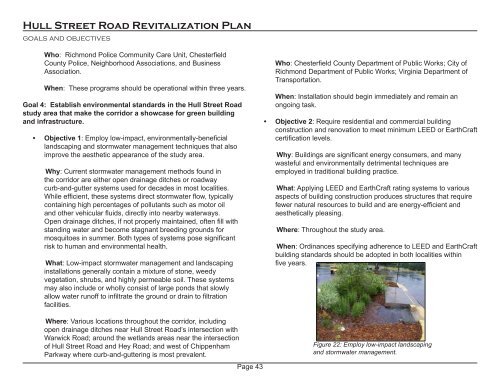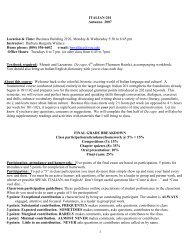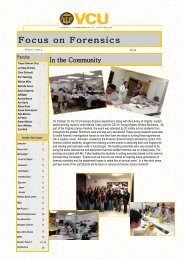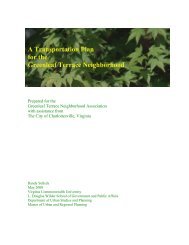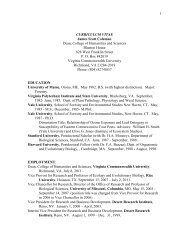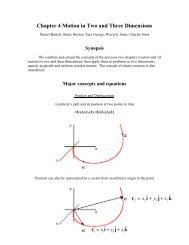Hull Street Road Revitalization Plan - College of Humanities and ...
Hull Street Road Revitalization Plan - College of Humanities and ...
Hull Street Road Revitalization Plan - College of Humanities and ...
Create successful ePaper yourself
Turn your PDF publications into a flip-book with our unique Google optimized e-Paper software.
<strong>Hull</strong> <strong>Street</strong> <strong>Road</strong> <strong>Revitalization</strong> <strong>Plan</strong><br />
goals <strong>and</strong> objectives<br />
Who: Richmond Police Community Care Unit, Chesterfield<br />
County Police, Neighborhood Associations, <strong>and</strong> Business<br />
Association.<br />
When: These programs should be operational within three years.<br />
Goal 4: Establish environmental st<strong>and</strong>ards in the <strong>Hull</strong> <strong>Street</strong> <strong>Road</strong><br />
study area that make the corridor a showcase for green building<br />
<strong>and</strong> infrastructure.<br />
• Objective 1: Employ low-impact, environmentally-beneficial<br />
l<strong>and</strong>scaping <strong>and</strong> stormwater management techniques that also<br />
improve the aesthetic appearance <strong>of</strong> the study area.<br />
Why: Current stormwater management methods found in<br />
the corridor are either open drainage ditches or roadway<br />
curb-<strong>and</strong>-gutter systems used for decades in most localities.<br />
While efficient, these systems direct stormwater flow, typically<br />
containing high percentages <strong>of</strong> pollutants such as motor oil<br />
<strong>and</strong> other vehicular fluids, directly into nearby waterways.<br />
Open drainage ditches, if not properly maintained, <strong>of</strong>ten fill with<br />
st<strong>and</strong>ing water <strong>and</strong> become stagnant breeding grounds for<br />
mosquitoes in summer. Both types <strong>of</strong> systems pose significant<br />
risk to human <strong>and</strong> environmental health.<br />
What: Low-impact stormwater management <strong>and</strong> l<strong>and</strong>scaping<br />
installations generally contain a mixture <strong>of</strong> stone, weedy<br />
vegetation, shrubs, <strong>and</strong> highly permeable soil. These systems<br />
may also include or wholly consist <strong>of</strong> large ponds that slowly<br />
allow water run<strong>of</strong>f to infiltrate the ground or drain to filtration<br />
facilities.<br />
Where: Various locations throughout the corridor, including<br />
open drainage ditches near <strong>Hull</strong> <strong>Street</strong> <strong>Road</strong>’s intersection with<br />
Warwick <strong>Road</strong>; around the wetl<strong>and</strong>s areas near the intersection<br />
<strong>of</strong> <strong>Hull</strong> <strong>Street</strong> <strong>Road</strong> <strong>and</strong> Hey <strong>Road</strong>; <strong>and</strong> west <strong>of</strong> Chippenham<br />
Parkway where curb-<strong>and</strong>-guttering is most prevalent.<br />
Who: Chesterfield County Department <strong>of</strong> Public Works; City <strong>of</strong><br />
Richmond Department <strong>of</strong> Public Works; Virginia Department <strong>of</strong><br />
Transportation.<br />
When: Installation should begin immediately <strong>and</strong> remain an<br />
ongoing task.<br />
• Objective 2: Require residential <strong>and</strong> commercial building<br />
construction <strong>and</strong> renovation to meet minimum LEED or EarthCraft<br />
certification levels.<br />
Why: Buildings are significant energy consumers, <strong>and</strong> many<br />
wasteful <strong>and</strong> environmentally detrimental techniques are<br />
employed in traditional building practice.<br />
What: Applying LEED <strong>and</strong> EarthCraft rating systems to various<br />
aspects <strong>of</strong> building construction produces structures that require<br />
fewer natural resources to build <strong>and</strong> are energy-efficient <strong>and</strong><br />
aesthetically pleasing.<br />
Where: Throughout the study area.<br />
When: Ordinances specifying adherence to LEED <strong>and</strong> EarthCraft<br />
building st<strong>and</strong>ards should be adopted in both localities within<br />
five years.<br />
Figure 22: Employ low-impact l<strong>and</strong>scaping<br />
<strong>and</strong> stormwater management.<br />
Page 43


